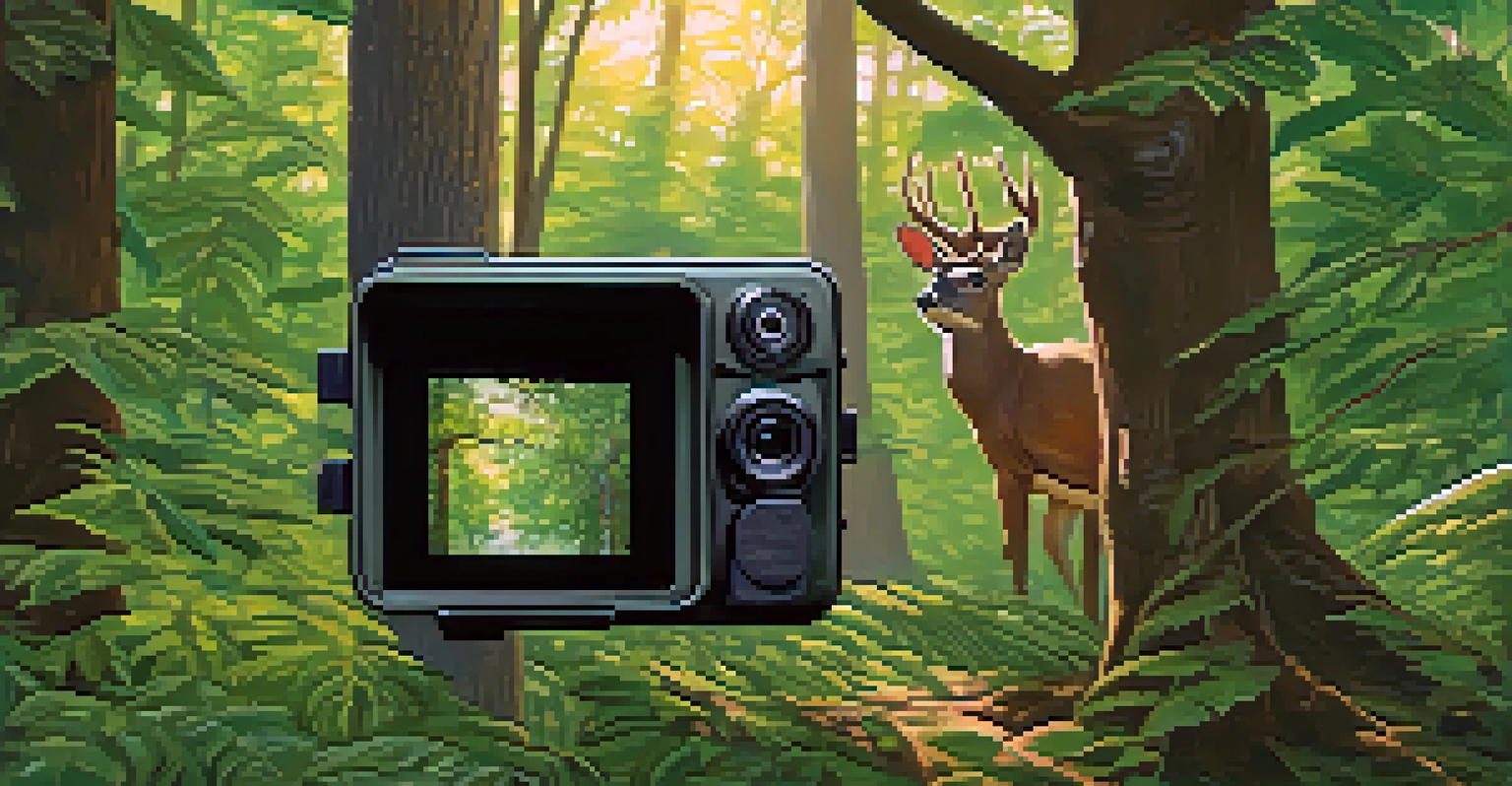Innovative Technologies for Wildlife Conservation in Georgia

The Role of Drones in Wildlife Monitoring
Drones have emerged as a game-changer in wildlife monitoring, offering a bird's-eye view of habitats. In Georgia, conservationists use drones to survey large areas quickly, which traditional methods might take weeks to cover. These aerial perspectives help track animal populations and gather critical data on their behaviors and movements.
The future of wildlife conservation lies in the hands of technology and the innovative minds that embrace it.
Moreover, drones equipped with thermal cameras can detect animals in dense forests at night, revealing patterns that were previously invisible to researchers. This not only enhances our understanding of wildlife but also aids in protecting endangered species from poaching and habitat destruction.
As technology continues to evolve, the potential for drones in conservation seems limitless. They can be deployed for real-time assessments, allowing for swift responses to environmental threats, making them an invaluable tool in the fight for Georgia's wildlife.
Camera Traps: Capturing the Wild
Camera traps have revolutionized wildlife research by providing a non-intrusive way to study animal behavior. In Georgia's diverse ecosystems, these devices capture thousands of images, revealing insights into species that are often elusive or nocturnal. This technology allows researchers to monitor animal populations without disturbing their natural habitats.

The data collected from camera traps offers invaluable information about biodiversity and can inform conservation strategies. For instance, by identifying which species are thriving and which are struggling, conservationists can tailor their efforts to protect vulnerable populations.
Drones Transform Wildlife Monitoring
Drones provide quick aerial surveys and critical data collection, enhancing wildlife conservation efforts in Georgia.
Additionally, these cameras can serve as powerful tools for engaging the public in conservation efforts. By sharing captivating images and videos online, organizations can raise awareness and inspire community involvement in protecting Georgia's wildlife.
Artificial Intelligence for Data Analysis
Artificial intelligence (AI) is making waves in wildlife conservation by analyzing vast amounts of data quickly and efficiently. In Georgia, AI algorithms can process data from various sources, including satellite imagery and camera traps, to identify patterns and trends in wildlife populations. This helps conservationists make informed decisions about resource allocation and management strategies.
In every walk with nature, one receives far more than he seeks.
For example, AI can predict animal migration patterns based on climate data, enabling proactive measures to protect habitats before animals are affected. This predictive capability is crucial, especially as climate change poses increasing threats to biodiversity.
Moreover, AI can assist in identifying species from images, even in challenging conditions. This means researchers can focus more on strategic planning and less on manual data processing, ultimately leading to more effective conservation efforts.
Mobile Apps Empowering Citizen Scientists
Mobile applications are empowering everyday citizens to contribute to wildlife conservation efforts. In Georgia, apps like iNaturalist encourage users to document local flora and fauna, creating a vast database of biodiversity. This citizen science not only enriches the available data but also fosters a sense of connection between people and nature.
Furthermore, these apps often include educational resources, helping users learn about the species they encounter. This engagement can lead to increased awareness and advocacy for wildlife conservation within local communities.
AI Boosts Conservation Strategies
Artificial intelligence analyzes vast data sets, enabling conservationists to make informed decisions and predict wildlife patterns.
By harnessing the collective efforts of citizens, conservation organizations can gather valuable data that would be difficult to obtain otherwise. This collaborative approach enhances the overall effectiveness of conservation initiatives in Georgia.
GIS Technology for Habitat Mapping
Geographical Information Systems (GIS) technology is crucial for mapping and analyzing wildlife habitats. In Georgia, GIS allows conservationists to visualize spatial data, highlighting important trends and areas that require protection. This technology helps identify critical habitats for endangered species, guiding conservation efforts where they are needed most.
Moreover, GIS can help predict how changes in land use or climate may impact wildlife habitats in the future. By understanding these potential changes, conservationists can develop proactive strategies to mitigate threats and preserve biodiversity.
GIS technology also facilitates collaboration among various stakeholders, including government agencies, NGOs, and local communities. By sharing data and insights, these groups can work together more effectively to ensure the survival of Georgia’s unique wildlife.
Genetic Research for Species Conservation
Advances in genetic research are playing a pivotal role in conservation biology. In Georgia, genetic analysis helps identify distinct populations of species, which is essential for effective conservation planning. Understanding the genetic diversity within a species can inform breeding programs aimed at increasing resilience against diseases and environmental changes.
For instance, genetic studies can reveal which populations are most vulnerable and require immediate intervention. This targeted approach ensures that conservation resources are allocated efficiently, maximizing the impact of efforts to save endangered species.
Community Engagement Drives Success
Mobile apps and technology engage citizens in documenting wildlife, fostering a deeper connection and support for conservation initiatives.
Moreover, genetic research can assist in restoring ecosystems by identifying key species that support ecological balance. By focusing on the genetic health of these species, conservationists can help maintain the integrity of Georgia's diverse ecosystems.
Community Engagement Through Technology
Engaging local communities in conservation efforts is vital for long-term success, and technology plays a key role in this engagement. In Georgia, initiatives often utilize social media and online platforms to raise awareness and encourage participation in conservation activities. Campaigns that showcase local wildlife can spark interest and pride in the community, leading to greater support for conservation initiatives.
Additionally, technology facilitates workshops and training sessions that educate the public on the importance of biodiversity and sustainable practices. By equipping community members with knowledge and tools, organizations can foster a sense of ownership and responsibility for local wildlife.

The integration of technology in community engagement not only strengthens conservation efforts but also builds lasting relationships between organizations and the communities they serve. This collaborative spirit is essential for protecting Georgia's wildlife for future generations.
The Future of Wildlife Conservation Technology
The future of wildlife conservation in Georgia is bright, thanks to ongoing technological advancements. As tools like drones, AI, and genetic research continue to evolve, they promise to enhance our understanding and protection of wildlife. The integration of these technologies will allow for more precise data collection and analysis, leading to more effective conservation strategies.
Moreover, as public interest in wildlife conservation grows, we can expect to see more innovative solutions emerging from the community and private sectors. This collaborative approach can drive the development of new technologies tailored to specific conservation challenges faced in Georgia.
Ultimately, the combination of technology and community engagement will play a crucial role in ensuring the survival of Georgia's unique wildlife for generations to come. By embracing innovation and collaboration, we can create a sustainable future for all living creatures.